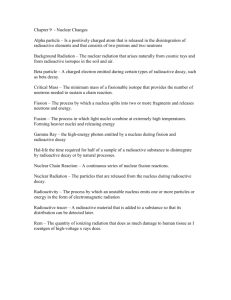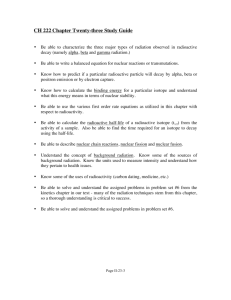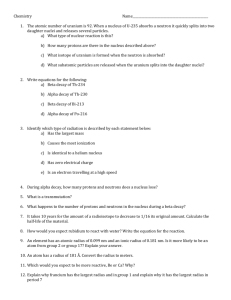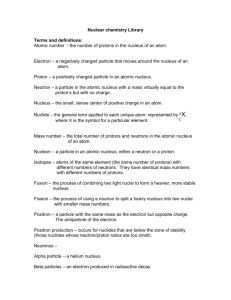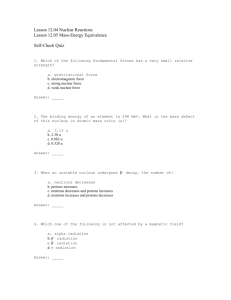Topic 7. 2 Radioactive Decay
advertisement
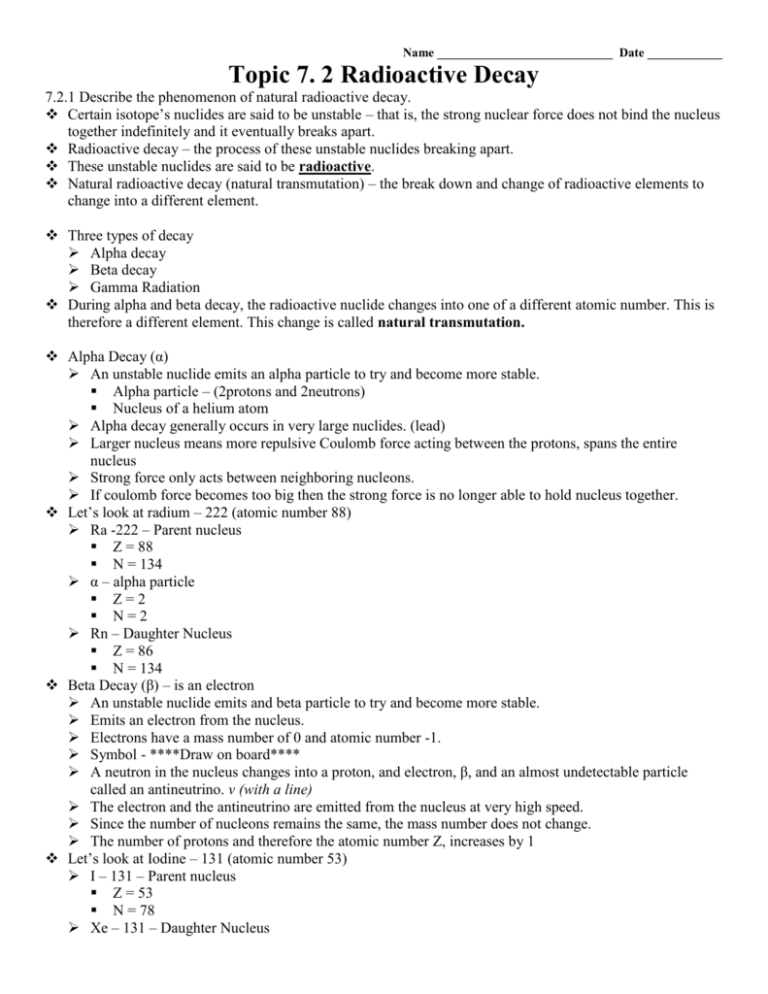
Name ____________________________ Date ____________ Topic 7. 2 Radioactive Decay 7.2.1 Describe the phenomenon of natural radioactive decay. Certain isotope’s nuclides are said to be unstable – that is, the strong nuclear force does not bind the nucleus together indefinitely and it eventually breaks apart. Radioactive decay – the process of these unstable nuclides breaking apart. These unstable nuclides are said to be radioactive. Natural radioactive decay (natural transmutation) – the break down and change of radioactive elements to change into a different element. Three types of decay Alpha decay Beta decay Gamma Radiation During alpha and beta decay, the radioactive nuclide changes into one of a different atomic number. This is therefore a different element. This change is called natural transmutation. Alpha Decay (α) An unstable nuclide emits an alpha particle to try and become more stable. Alpha particle – (2protons and 2neutrons) Nucleus of a helium atom Alpha decay generally occurs in very large nuclides. (lead) Larger nucleus means more repulsive Coulomb force acting between the protons, spans the entire nucleus Strong force only acts between neighboring nucleons. If coulomb force becomes too big then the strong force is no longer able to hold nucleus together. Let’s look at radium – 222 (atomic number 88) Ra -222 – Parent nucleus Z = 88 N = 134 α – alpha particle Z=2 N=2 Rn – Daughter Nucleus Z = 86 N = 134 Beta Decay (β) – is an electron An unstable nuclide emits and beta particle to try and become more stable. Emits an electron from the nucleus. Electrons have a mass number of 0 and atomic number -1. Symbol - ****Draw on board**** A neutron in the nucleus changes into a proton, and electron, β, and an almost undetectable particle called an antineutrino. v (with a line) The electron and the antineutrino are emitted from the nucleus at very high speed. Since the number of nucleons remains the same, the mass number does not change. The number of protons and therefore the atomic number Z, increases by 1 Let’s look at Iodine – 131 (atomic number 53) I – 131 – Parent nucleus Z = 53 N = 78 Xe – 131 – Daughter Nucleus Z = 54 N = 77 Gamma Radiation (γ) After alpha or beta emission, the daughter nucleus is left in an “excited state”. The protons and neutrons reorganize themselves in an attempt to become more stable. As they do this they lose energy. This energy is emitted from the nucleus as a pulse of gamma radiation This energy emission is a little like the energy emitted from an atom as an electron drops to a lower energy state. However, the energy levels oa a nucleus are much wider than that. Where an atom emits radiation in the order of a few eV, the nucleus emits radiation in the range of a few keV, or a few MeV 7.2.2 Describe the properties of alpha (α) and beta (β) particles and gamma (γ) radiation. Alpha (α) Helium nucleus +2 charge Mass: 4u(7350 x me Strong ionizing ablility Stopped by a sheet of thick paper or card or by the skin. Travels a few cm in air Effect in an electric field ***See board*** Effect in an magnetic field ***See board*** Beta (β) High speed electron -1 charge Mass: 1/1800u Weak ionizing ability Stopped by a few mm of aluminum or other metals. Travels up to a meter in air. Effect in an electric field ***See board*** Effect in an magnetic field ***See board*** Gamma (γ) Electromagnetic Wave 0 Mass: 0u Very weak ionizing ability Never completely stopped although reduced by thick concrete or lead. Effect in an electric field ***See board*** Effect in an magnetic field ***See board*** Decay Series Parent nuclide don’t always decay into a stable daughter nucleus. The daughter nucleus then needs become the parent and decay again, producing another daughter. This will continue until there is a stable nuclide. 7.2.3 Describe the ionizing properties of alpha (α) and beta (β) particles and gamma (γ) radiation. 7.2.4 – Outline the biological effects of ionizing radiation. Ion is a charged atom. Atoms become ionized by gaining or losing electrons. Ionizing radiations – radiation that has the ability to strip away electrons. Can damage or destroy cells. Can alter the chemical information in cells. Can cause mutations and/or cancer. The ionization effects of radiation can be used to detect and identify the different forms of radiation. 7.2.5 Explain why some nuclei are stable while others are unstable. Two interactions inside the nucleus. Coulomb, electrostatic force and Strong Nuclear Force. Very fine balance must be maintained to stay stable. Neutrons help to increase the nucleus size and keep protons further apart to reduce the coulomb repulsive forces. There has to be just the right ratio of neutrons to protons. If it’s not just right the strong force is reduced the nucleus becomes unstable This graph shows the relationship between neutrons and protons. Stable nuclides – Z < 20 Protons and neutrons are about equal Above 20 the nuclides have more neutrons than protons. 7.2.5 Explain why some nuclei are stable while others are unstable. Nuclides above the stability line have too many neutrons Beta minus (electron emission) Nuclides below the stability line have too few neutrons Beta plus (positron emission) Positron is same mass and size charge as electron only positive. Larger unstable nuclides decay by alpha emission. Above Z = 83 7.2.5 Explain why some nuclei are stable while others are unstable. Detection of Radiation Gold Leaf Electroscope Source of radiation is brought close instrument Air around the cap is ionized. Gold leaf rises due to electrostatic induction. GLE only detects alpha radiation since alpha is highly ionizing. Ionization Chamber Rutherford used Can detect all three forms of ionizing radiation Chamber is made of a metal box and a central wire electrode. Radioactive source is place in a chamber. As the air is ionized, to becomes electrically conductive A small current flows which is detected w/ a sensitive ammeter. Geiger–Muller (GM) tube Used instead of Ionization chamber Works on same principle as the ionization chamber. Difference is the source does not have to be physically placed inside the chamber. Measured in Becquerels, Bq If radiation enters the tube it ionizes the gas and causes a high voltage spark between the central wire and the outer metal body. An electric current flows. Counts the number of sparks which indicates the total number of particles to enter the tube. Half – Life 7.2.6 State that radioactive decay is a random and spontaneous process and that the rate of decay decreases exponentially with time. 7.2.7 Define the term radioactive half-life. If you were to toss a coin, then on average half the time the coin would turn up heads and the other half it would turn up tails. However each toss is completely random and independent of other tosses. Tossing the coin is random of each toss but predictable over an extended series of tosses. Half-life – Random and spontaneous process – food for thought. Stochasticity (9:00 – 18:00) http://www.radiolab.org/2009/jun/15/ Are we coins? http://www.radiolab.org/blogs/radiolab-blog/2009/jun/29/are-we-coins/ This is similar with radioactive decay. It is a random process with a predictable outcome. Any nuclide, over time, half the unstable nuclei will decay in attempt to become more stable. Exponential decay Can be graphed/plotted IB Definition - Half–life is the time taken for half of the undecayed nuclei, remaining in a given sample, to decay. - Applied to using a Geiger counter - half-life is the time taken for the activity of a given sample to fall to half of its original value. Number of undecayed nuclei N (x10^6) 7.2.8 Determine the half – life of a nuclide from a decay curve. Lets use the isotope Iodine–131 – beta emission. The time taken for the number of undecayed 2000 nuclei to drop from 1200x106 down to 600x106 is 8 days 1500 The time taken for the number of undecayed nuclei to drop from 1000 6 400x10 down to 200x106 is 8 days as 500 well. It does NOT depend on the INITIAL 0 amount of the quantity. 0 10 20 Time t/days 30 7.2.9 Solve radioactive decay problems involving integral numbers of half–lives . Example problem 1 A sample of Radon – 220 was measured to have an activity of 1440Bq. The same sample was measured 4 minutes 20 seconds later to have an activity of 45Bq. Calculate the half-life of Radom-220. Answer: 52seconds Example problem 2 Nuclide X is radioactive, decaying with a half-life of 6.0 minutes to a daughter nuclide Y, which is stable. A sample originally consists entirely of nuclide X. Construct a graph showing the number of undecayed x nuclei in the sample as a function of time. The initial number is shown at point A. On the same axes construct another graph showing the number of daughter (Y) nuclei as a function of time. Label this graph Y. Determine the ratio of Y and X nuclei after 18 minutes. 40


